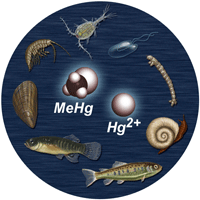Project Leader:
Celia Y. Chen, Ph.D.
Director
Toxic Metals Superfund Research Program
Research Professor
Department of Biological Sciences
Dartmouth College
Research Scientist:
Kate Buckman, Ph.D.
Department of Biological Sciences
Dartmouth College
Project Co-Leaders:
Robert Mason, Ph.D.
Professor of Marine Sciences, University of Connecticut
Nicholas S. Fisher, Ph.D.
Distinguished Professor & Director, Consortium for Inter-Disciplinary Environmental Research, Stony Brook University
For over 20 years, our lab has studied the fate of toxic metals in aquatic ecosystems. Our study systems have ranged from lakes, ponds, and reservoirs to coastal estuaries and open water marine sites, and have included a gradient from contaminated Superfund sites to relatively un-impacted sites in rural New England. In all of our research, we are interested in how metals in sediments and water are taken up by organisms at the base of the food web and then transferred to higher trophic levels. Our current research focuses on mercury in aquatic ecosystems. Mercury takes several forms in the environment, including elemental, inorganic, and organic mercury. The most toxic and bioavailable form is organic mercury, or methylmercury. Inorganic mercury is transformed into methylmercury by bacteria which live in aquatic environments. This methylmercury can then enter the aquatic food web and be transferred from prey to consumer, biomagnifying as it moves up the food chain, and ultimately ending up in fish. Consumption of fish is the most common source of human exposure to methylmercury, which can cause developmental delays in children, motor impairment, cardiovascular effects and other serious health effects. Consumption of mercury-contaminated fish is a public and environmental health concern, and mitigating exposure to methylmercury drives our research questions.
Elevated inputs of inorganic mercury to ecosystems (from past and present human activities such as coal burning, mining, and industrial processes) are generally thought to result in high methylmercury concentrations in fish inhabiting those ecosystems. However, there are many factors that mediate the fate and trophic transfer of mercury in the environment. Elevated methylmercury concentrations in fish and fish-eating birds and mammals result from a complex sequence of biotic and abiotic mechanisms. These controls on the transport and availability of inorganic mercury and production, bioaccumulation, and biomagnification of methylmercury are not fully defined or understood. Through our research we hope to examine the ways in which changing climatic conditions will impact methylmercury production in aquatic ecosystems. This, combined with our past studies in lakes, streams, rivers, and estuaries, will help us better understand the mechanisms that result in elevated methylmercury concentrations in the fish that humans consume.
The current goal of our research project is to investigate the effects of multiple environmental factors associated with climate change on methylmercury production and bioaccumulation in coastal ecosystems. Current climate change models predict increases in temperature, stream flows, and sea level in coastal waters. These changes will impact the thermal conditions, nutrient and carbon loading, and salinity of these ecosystems. We are using experimental approaches, field studies, and bioaccumulation modeling to examine the combined and interactive effects of temperature, salinity and organic carbon on methylmercury production and fate in estuaries.
Publications
Celia Chen Pubmed
Robert Mason Pubmed
Nicholas S. Fisher All Publications
